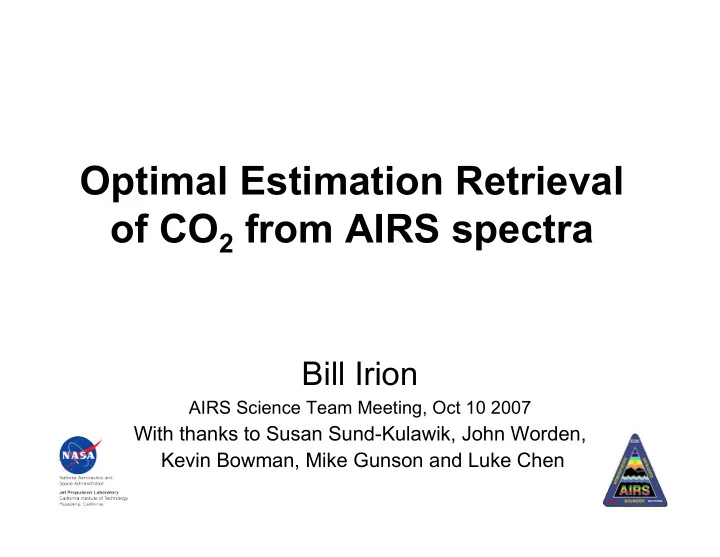

Optimal Estimation Retrieval of CO 2 from AIRS spectra Bill Irion AIRS Science Team Meeting, Oct 10 2007 With thanks to Susan Sund-Kulawik, John Worden, Kevin Bowman, Mike Gunson and Luke Chen 1
Goals: • Develop a method using Optimal Estimation (OE) techniques (including constraints) to retrieve upper tropospheric CO 2 . • Compare retrievals with Vanishing Partial Derivatives (VPD) results. • Emphasis is on distribution of results – Biases possible between OE and VPD because of different forward models and re-retrieval of temperature and water vapor profiles 2
Methodology: • TES code and forward model. • AIRS cloud-cleared radiances. • Temperature and water vapor profiles retrieved prior to CO 2 retrieval. • Water and ozone simultaneously retrieved as “interferent gases” in CO 2 retrieval. 3
What’s in the window? 4
Measurement location Noisy measurement for AIRS so we need to average results 5
Optimal Estimation Cost Function T + x � x c � 1 y � F( x ) ( T ) ( ) S n ( ) ( ) � x � x c ( ) C = min y � F( x ) x 2 + x � x c � ( ) 2 = min y � F( x ) S n � 1 x ˆ x = retrieved state x = true state x c = first guess y = observed radiance -1 = noise covariance matrix F(x) = forward model S n � = constraint matrix (usually inverse of a priori covar matrix) 6 (This ignores mappings used in retrieval scheme.)
Optimal Estimation Cost Function T + x � x c � 1 y � F( x ) ( T ) ( ) S n ( ) ( ) � x � x c ( ) C = min y � F( x ) x 2 + x � x c � ( ) 2 = min y � F( x ) S n � 1 x ˆ x = retrieved state x = true state x c = first guess y = observed radiance -1 = noise covariance matrix F(x) = forward model S n � = constraint matrix (usually inverse of a priori covar matrix) What to choose for constraint? 7 (This ignores mappings used in retrieval scheme.)
An ad hoc covariance/constraint Note that we’re retrieving a ln (mixing ratio) profile On the diagonal: Log 10 covariance 2 � � � � � � 0.01 S i , i = ln � + 1.01 � � � ( ) 1 + 0.03 z / � z � � � � � � β is the fractional std. dev. at surface z = altitude δ z = vertical spacing Off diagonals 1 : � � S i , j = S i , i exp � i � j � z � � � h � h = off-diagonal length scale Individual errors not rigorous because of ad hoc constraint β = 0.08; h = 0.5 km 8 1 per Rodgers [2000]
Sample Averaging Kernel Varies observation to observation Average channel SNR for this example = 114 Peak sensitivity from ~200 to 400 mb Diagonal of constraint matrix largely determines sensitivity. Off-diagonals determine resolution. h = 0.5 km, a priori σ 260mb = 5.6% 9
Average retrieval results over granule Analysis over granule repeated five times using same constraint but different 1st guess profiles (a priori) 10
Retrievals over granule @ 261 mb (1.7 %) 11
Comparison to Vanishing Partial Derivatives Thanks to Luke Chen for VPD processing 12
Clustered comparison to Vanishing Partial Derivatives Optimal Estimation retrievals filtered and averaged similar to VPD. 13
Conclusions • With OE, “loose” diagonal and low off-diagonals in a priori covariance give robust retrievals in the aggregate • Comparable distribution of results to VPD • Need to understand bias between OE and VPD results – Forward model (incl. spectroscopy differences)? – Temperature profile? • Need to merge in AIRS forward model to increase speed of retrieval, and provide data on monthly timescales. 14
Backup Slides 15
Repeat the analysis with different covariance matrices On the diagonal: Log 10 covariance h h h 2 � � � � � � 0.01 S i , i = ln � + 1.01 � � � ( ) 1 + 0.03 z / � z � � � � � � β is the fractional std. dev. at surface z = altitude δ z = vertical spacing Off diagonals: � � S i , j = S i , i exp � i � j � z � � � h � h = off-diagonal length scale 16
Averaging kernels Average channel SNR for this example = 114 Peak sensitivity from ~200 to 400 mb Diagonal of constraint matrix largely determines sensitivity. Off-diagonals determine resolution. 17
Averaged results (all covar matrices) 18
Effect of “looser” constraint 5.6% a priori 8.2% a priori 46% error at 260 mb error at 260 mb increase σ = 1.7% σ = 2.1% 24% increase 19
No correlation between VPD and OE cluster results 20
Recommend
More recommend